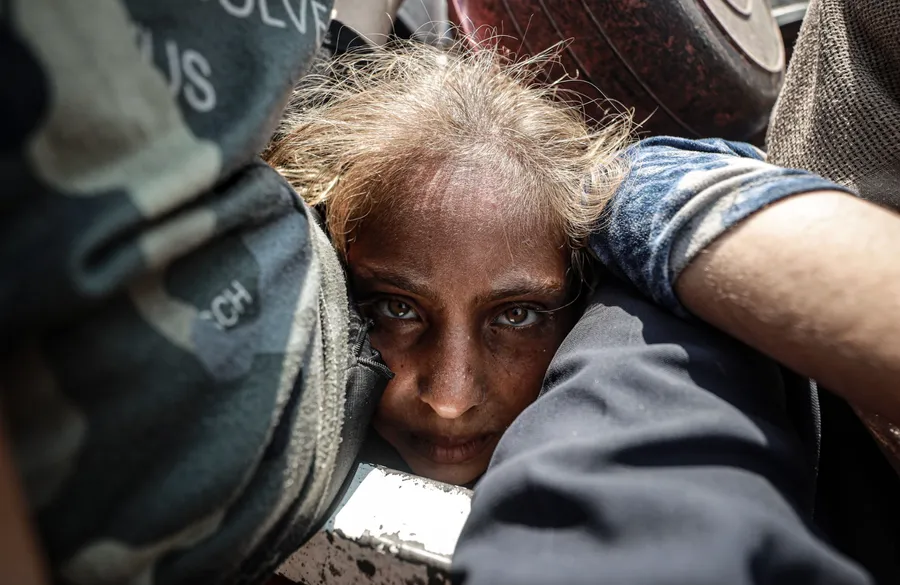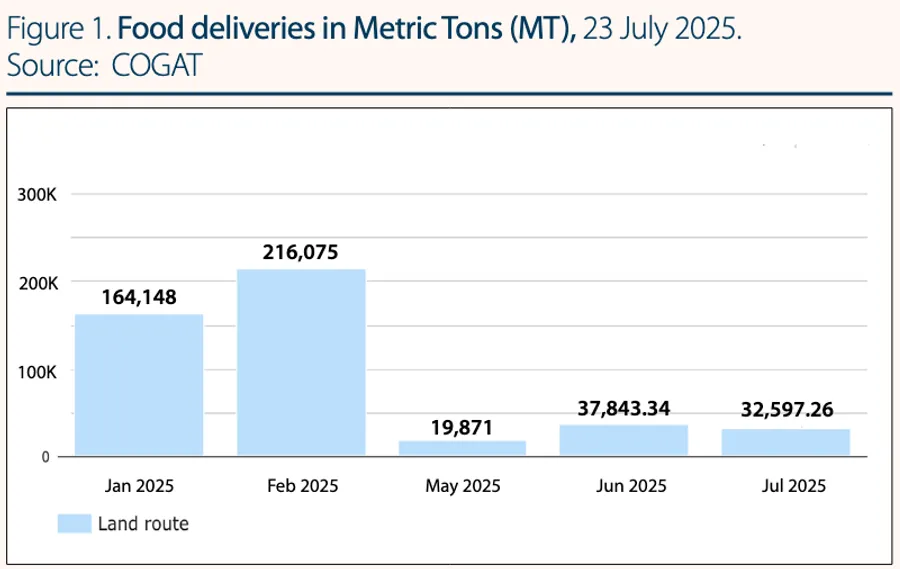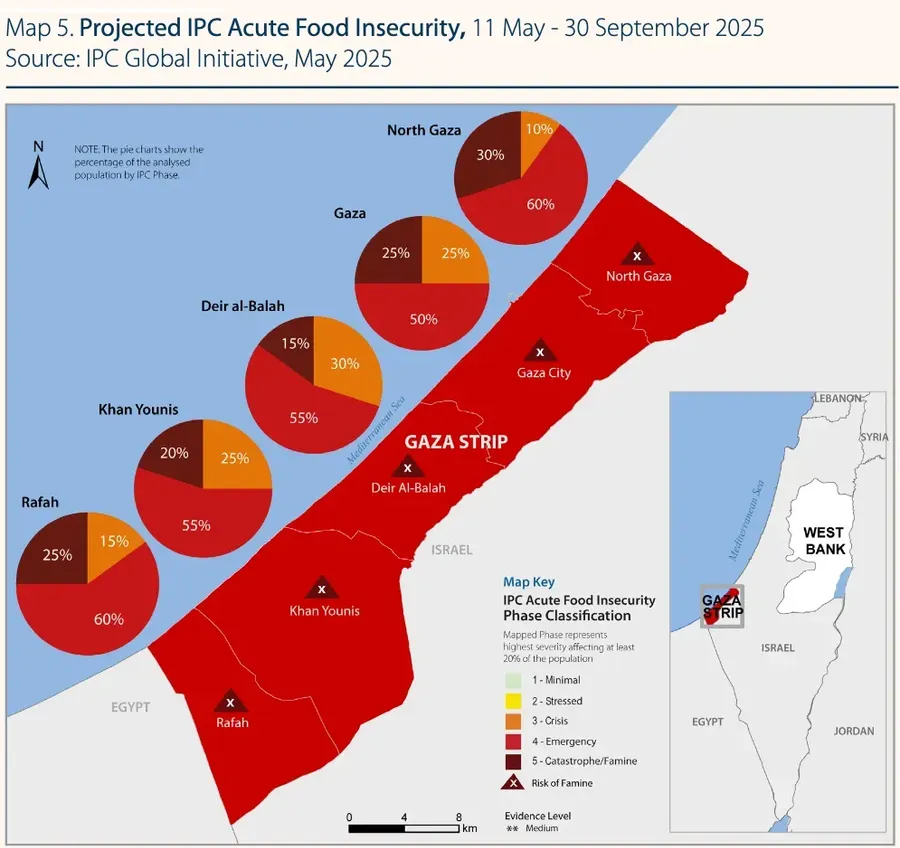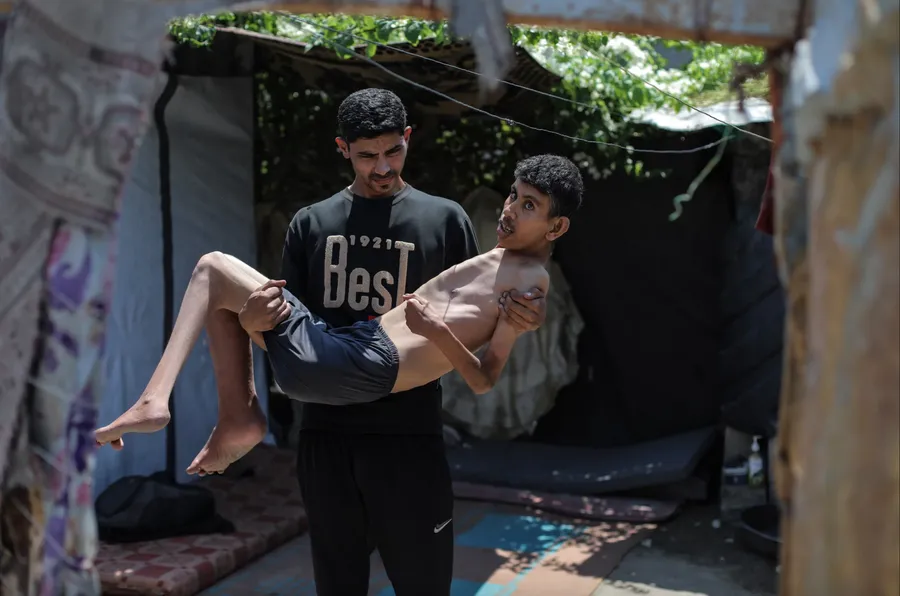
Starvation in the Rubble
by u/DemosthenesRex
The Gaza Strip has undergone a humanitarian collapse of staggering proportions, characterized not only by infrastructural devastation but also by the rapid deterioration of public health, food security, and civilian survival mechanisms. What began as a high-intensity military campaign has metastasized into one of the most acute humanitarian crises of the twenty-first century, where famine is no longer a hypothetical threat but an emerging reality. Reports from United Nations agencies, international aid organizations, and medical personnel on the ground uniformly underscore a singular and harrowing fact. Large portions of Gaza’s population are starving under siege, cut off from consistent access to food, water, medical care, and safe shelter.
This article seeks to examine the multifaceted causes and implications of that collapse through the lens of humanitarian infrastructure: its targeted destruction, logistical suffocation, and the compounded failures of international diplomacy. The Israeli military campaign, though officially framed as a counterinsurgency operation against Hamas, has involved sustained bombardment of critical civilian infrastructure, hospitals, water treatment plants, and food storage facilities, resulting in the wholesale degradation of Gaza’s ability to sustain life. At the same time, restrictions on humanitarian access, including closed border crossings, intermittent aid deliveries, and opaque inspection regimes, have made it impossible for international actors to offset the spiraling crisis with even baseline relief.
In evaluating these conditions, the article does not treat the crisis in Gaza as a mere collateral outcome of war but instead interrogates it as a systemic failure, or in some interpretations, a deliberate policy of siege warfare in a densely populated civilian enclave. It explores the coordinated interplay between military strategy and logistical obstruction, and assesses how the current situation has transformed international norms around humanitarian access, collective punishment, and civilian protection. Ultimately, this investigation raises critical questions about the future of Gaza’s population, the credibility of the international humanitarian system, and the political will, or lack thereof, to prevent famine from becoming an instrument of policy.
The collapse of Gaza’s humanitarian infrastructure is not merely the collateral damage of protracted urban warfare, it represents a comprehensive degradation of civil systems essential to life. Israeli strikes have struck power plants, hospitals, desalination facilities, and food warehouses with alarming regularity, producing cascading effects on every facet of daily survival. The loss of electricity has crippled water purification and refrigeration systems, undermining the preservation of food and vaccines. Simultaneously, the destruction of transportation arteries has rendered the movement of relief supplies nearly impossible, fragmenting local aid distribution networks already strained by siege conditions. In effect, Gaza has transitioned from a besieged territory to a landscape of engineered collapse, where the distinction between military target and civilian lifeline grows ever more obscured.
At the epicenter of this infrastructural disintegration is the health care system, now operating as a ghost of its prewar self. Surgical wards function without anesthesia, dialysis units have shut down, and infectious disease outbreaks surge in the absence of clean water or waste management. The collapse of telecommunications infrastructure further complicates coordination between field medics and hospitals, delaying critical interventions. Humanitarian actors report that the destruction appears not random but systematic, aimed at facilities indispensable to public health and logistics. In such an environment, medical care becomes both a casualty and a battlefield, exposing the grim logic of a war where infrastructure is not merely neglected but actively dismantled, and where the erosion of civilian life is inseparable from the prosecution of military objectives.
Despite repeated international appeals for unimpeded humanitarian access, the entry of aid into Gaza remains hostage to an intricate matrix of bureaucratic restrictions and operational bottlenecks. Israel’s security protocols, including extensive inspections of trucks and cargo at crossings like Kerem Shalom and Rafah, have effectively reduced the volume of incoming aid to a trickle, even as the humanitarian emergency deepens. According to reports from both the UN and aid organizations on the ground, perishable goods often expire before clearance is granted, and vital items such as fuel and medical equipment are either denied entry outright or significantly delayed. In practice, these restrictions serve not merely as logistical obstacles but as systemic constraints on the capacity of humanitarian actors to operate within the enclave, reinforcing a siege dynamic that has pushed Gaza’s infrastructure into near-total collapse.


(Top) A graph showing the amount of food deliveries in Gaza by month in 2025, courtesy of the Israeli government. Months are missing due to Israel's complete blockade of humanitarian aid from March 2nd to May 19th this year.
(Bottom) An illustration of the IPC's projected classifications for the 2nd half of 2025
Both sourced from: https://www.ipcinfo.org/fileadmin/user_upload/ipcinfo/docs/IPC_GazaStrip_Alert_July2025.pdf
Compounding the access restrictions is the deliberate limitation on fuel, commodity critical not only for transportation and hospital generators but for the operation of bakeries, water pumps, and refrigerated storage for medicine and food. Without sufficient diesel, aid convoys are unable to distribute the limited supplies that do enter, rendering even successful border deliveries only partially effective. These constraints create a situation wherein humanitarian assistance is not only rationed at the source but fragmented across its entire supply chain. The result is a form of structural paralysis, in which well-funded international efforts to alleviate suffering are neutralized by tactical policy decisions that prioritize security imperatives over civilian survival.
International humanitarian organizations have encountered unprecedented operational paralysis in Gaza, not merely due to the magnitude of the crisis but also as a consequence of deliberate political and military obstruction. Various aid groups have faced constraints ranging from restricted access to damaged infrastructure, to direct threats against personnel. In many cases, relief convoys have been denied entry or subjected to repeated inspections, despite carrying pre-approved, life-saving medical and nutritional supplies. Israel’s insistence on tightly controlling aid logistics, citing security concerns and the potential for Hamas exploitation, has resulted in a logjam of critical goods at border crossings, with perishable items left to rot and medicine stockpiled just kilometers from collapsing hospitals.
Efforts by the international community to coordinate relief under these conditions have been further complicated by politicization and disinformation. While Israeli officials have alleged that Hamas diverts aid for military use, a recent USAID analysis found no credible evidence of large-scale misappropriation, raising the possibility that these claims serve as a pretext for broader interdiction. International NGOs find themselves caught in a bureaucratic vise. Accountable to donors, mistrusted by the host government, and operating in a theater where neutrality is both weaponized and impossible to maintain. As a result, the humanitarian crisis in Gaza has evolved into a crisis of humanitarianism itself, where the basic principles of impartial aid delivery are subordinated to the logic of siege warfare and securitized policy. The erosion of these norms has far-reaching implications not only for Gaza but for humanitarian response in future conflicts where access is treated as leverage rather than obligation.
The humanitarian catastrophe unfolding in Gaza has escalated into what multiple international observers now characterize as a famine. As the destruction of agricultural systems, commercial food infrastructure, and water networks converges with systematic impediments to humanitarian relief, the population, particularly children and the elderly, faces escalating malnutrition and starvation. Despite the Israeli military’s announcement of daily "tactical pauses" to facilitate aid delivery, these measures appear insufficient in both scope and consistency. Aid convoys face chronic security risks, logistical bottlenecks, and inconsistent permissions at border crossings, rendering the idea of meaningful relief illusory.

Hamza Mishmish, 25, of Gaza shows signs of severe malnutrition and bone loss in the Nuseirat refugee camp amid worsening hunger in the region. The date of the photo is July 27. Hassan Jedi/Anadolu/via Getty Images
The characterization of food insecurity as an incidental consequence of war is increasingly being challenged by humanitarian experts who argue that the denial of sustenance, when implemented systematically, constitutes the strategic use of starvation as a weapon. International humanitarian law, particularly Additional Protocols of the Geneva Conventions, prohibits the starvation of civilians as a method of warfare, yet the observable metrics, infant wasting, price inflation of staple goods, and the collapse of distribution chains, point toward a policy environment in which deprivation is being operationalized. The ethical stakes are further heightened by the use of bureaucratic obfuscation and contradictory messaging. While airdrops and ceasefire pauses are touted as good-faith efforts, they often coincide with intensified military activity that renders aid corridors unsafe or unviable. Thus, the line between negligence and intent becomes dangerously indistinct, with implications not only for Gaza’s immediate survival, but for the integrity of the international humanitarian order.
The protracted collapse of Gaza’s public health infrastructure has set the stage for a cascading humanitarian catastrophe whose long-term ramifications will reverberate for generations. As potable water becomes increasingly scarce, the population faces a surge in waterborne diseases such as cholera, dysentery, and hepatitis A, ailments particularly lethal in densely populated and unsanitary environments. The collapse of immunization campaigns, pediatric care units, and prenatal services compounds the crisis, placing pregnant women, newborns, and young children in harrowing conditions. Simultaneously, Gaza’s only remaining dialysis and oncology facilities have ceased operating due to fuel shortages and infrastructural damage, leaving thousands of chronically ill patients without access to lifesaving treatment. This public health implosion cannot be understood as merely collateral, it is systemic, cumulative, and potentially irreversible.
The humanitarian catastrophe unfolding in Gaza is not merely a collateral consequence of military escalation; it is, increasingly, the foreseeable outcome of a political and strategic framework that has subordinated civilian survival to security imperatives. The deliberate throttling of aid via inspections, fuel denials, and logistical paralysis, has dismantled Gaza’s capacity to support even rudimentary public health. Simultaneously, the calibrated destruction of food infrastructure, water treatment systems, and healthcare facilities has functioned less as battlefield necessity than as a means of systemic incapacitation. The resulting famine-like conditions are not accidental but emerge from policies that inhibit humanitarian access while denying culpability, thereby constructing a warzone where hunger and disease are weaponized forms of pressure.
This approach raises urgent moral and legal questions. International humanitarian law, particularly the Geneva Conventions, draws sharp distinctions between combatants and civilians and prohibits collective punishment. Yet the observable pattern in Gaza, of delayed convoys, blocked crossings, and medical collapse, suggests not a failure of logistics, but the use of bureaucratic and kinetic tools to modulate suffering. Tactical pauses, while welcomed, have proven insufficient when the broader architecture of siege remains intact. When hunger becomes calibrated, not incidental, the international community must grapple with whether it is witnessing the slow articulation of a manufactured famine, a condition increasingly recognized by NGOs and UN officials alike.
Ultimately, the crisis in Gaza compels a reorientation of how we interpret the boundaries of war and humanitarian obligation. The decimation of Gaza’s civilian life support systems, paired with half-measures and rhetorical concern, illustrates a global failure to enforce even the most basic norms of humanitarian conduct. It is no longer sufficient to frame Gaza’s suffering as an unfortunate side effect of war; rather, it must be seen as a central feature of the current campaign. In failing to secure sustained and unconditional humanitarian access, the international system risks not only the further immiseration of Gaza’s population, but also the erosion of the moral and legal foundations that underpin the global order.